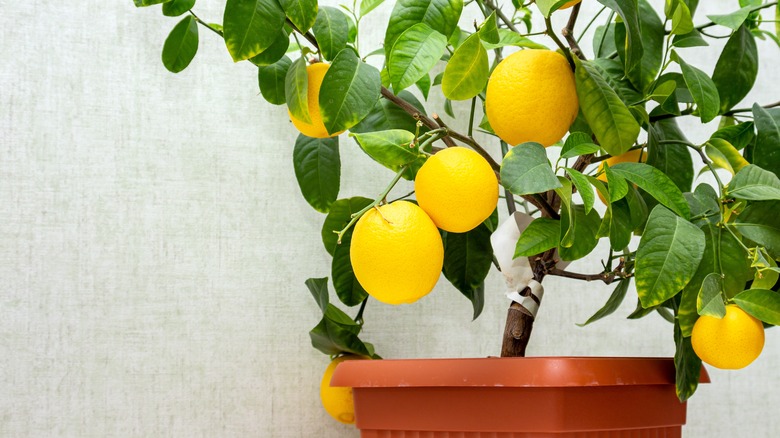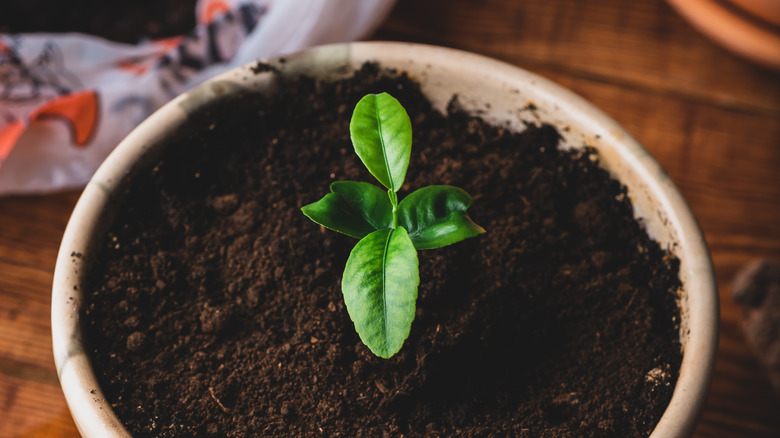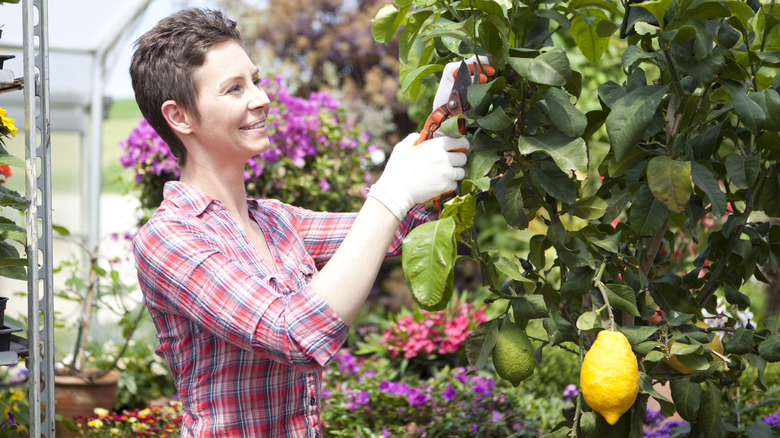You Don't Need A Big Outdoor Space To Grow A Lemon Tree. Here's How To Do It Indoors
When you think of lemons, you probably imagine them growing in massive, sprawling trees in warm-weather orchards. But the truth is that you can have a fruit-producing lemon tree at home even if you don't have a large yard to plant them in. In fact, you don't even need to keep these trees outdoors at all, nor do these trees need much room to flourish and bear fruit. You can start your lemon tree at home in a container that measures just half a foot, upgrade it to a foot-wide pot at maturity, and still expect a few fruits on the branches at the end of the growing season.
Like other citrus plants, lemon trees need little to survive and even thrive. Once you've bought or assembled the optimal potting mix, all you'll need to worry about is giving the trees enough light, consistent moisture, and annual pruning to keep their growth in check. You can propagate these trees easily, and a simple trick can help you pollinate their blooms to increase the chances of fruit production. Below, we cover everything you need to know about growing indoor lemon trees, from planting to ongoing care and propagation.
Best practices for growing lemon trees indoors
First, you should find a suitably sized pot and create an appropriate potting mix for the tree. If you're starting with a young planting from the nursery, a pot with a 12-inch diameter will suffice. Since lemon trees like acidic soil that drains well, fill the pot with one-third perlite, one-third peat, and one-third sterile potting soil. The perlite aerates the potting mix and helps it shed excess water, while the peat adds acidity. You can substitute perlite with vermiculite, which also aids aeration and drainage.
Lemon trees need to get full sun for at least six to eight hours daily, so find a bright location for the pot indoors. Apart from being bright, the location should have an ambient air temperature of roughly 65 degrees Fahrenheit to encourage growth. Come summer, move the tree outside. Do so gradually — lemon trees need time to acclimate to the brighter lighting conditions. First place it in a shady location, then move it to a sunnier spot after a few days. Conversely, acclimate them to the darker environment a shady part of the yard before moving them back inside.
Lemon trees need adequate irrigation to thrive, and you can use your finger to check if the tree needs watering. If the soil feels dry to a depth of 2 inches, add water to the growing medium. Likewise, fertilize the plant with food made for plants that like acid during its growing season.
How to prune, propagate, and pollinate your indoor lemon tree
Indoor lemon trees do need pruning if you want to keep them from growing too big a canopy. To give these trees the desired shape, you can cut them down to the lateral branches. This procedure is best performed in the spring. Along with pruning, it's good practice to wash the trees' foliage — this will not only clean the leaves, but also keep insects like spider mites from harming your plants.
You can propagate a lemon tree from cuttings in the late spring or early summer. Look out for shoots that have had time to harden, cut them, and place them in a container with a well-moistened potting medium. Once the roots extend beyond an inch, transplant them to a pot with the same type of medium you're using for adult plants. Alternatively, you can also try to grow lemon trees from seed.
If you're growing the citrus trees indoors, chances are you expect a harvest at the end of the growing season. Unfortunately, you won't always get lucky with a bountiful harvest, but to give your tree the best chances of producing fruits, you'll need to help it pollinate. The trees are self-pollinating, so you can pollinate a single tree by giving it a light shake when it's in bloom. This process replicates the natural pollination that occurs when the plants are growing outdoors and are exposed to insects and wind.


